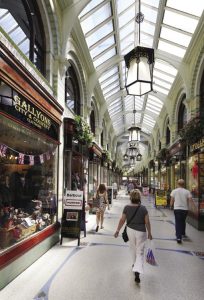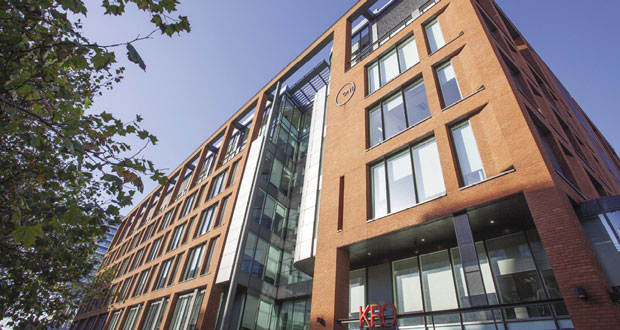MOBILISATION AND BEYOND
Mobilising the contract was a complex process, as operationally, it involved a range of assets, including multi-lets, retail parks, industrial centres and a range of commercial office occupiers with different needs. Because each site is different, the way it is managed is aligned to an individual ‘Asset Operation Plan’. This encompasses a range of targets including energy management, project works, social value and upcoming lease breaks. But unlike the typical hierarchical model between managing and FM operations, everyone works in partnership to help create welcoming and productive environments for occupiers.
Says Smart: “To get the contract up and running required dedication, commitment and good communication, all of which was led by LGIM pulling it all together with Bellrock and the managing agents. When the first COVID-19 spike kicked in we’d just completed the mobilisation of our final assets and gone live, consequently if you’re going to stress test the operating model, the operational resilience and the capability of the team being put them into the environment we were in back in April.”
Tyson agrees: “We’d already set out to have close occupier relationships so when COVID hit we saw that of our two main aims, proximity (i.e. getting closer to the occupier) and agility we’d really need to see how agile we were. We set up fortnightly meetings with our occupier representatives at an asset level, including PMs, asset managers and SDMs to check on progress, it was so successful it’s now something we’ve all agreed won’t go away after the pandemic is over, as we’ve built up such a positive relationship.”
Measuring occupancy satisfaction rates is always a point of stress for FM and the Mercury Model has truly grabbed the nettle by employing the use of QR codes to get a snapshot of day-to-day user satisfaction alongside a regular strategic occupier survey. Using Net Promoter Scores more often seen in the hospitality or consumer facing businesses LGIM have been able to drive focus on these scores alongside traditional metrics.
Says Tyson: “The QR code posters were installed in around 32 offices at the beginning of 2020. We ask just a couple of questions, ‘what can we do to improve and would you recommend this as a place to work out of five?’ We didn’t know what to expect when we opened up a direct channel to our teams for feedback but we didn’t expect the balance between positive and negative which came from listening and taking direct action. We learnt quickly that if we acted on feedback relating to cleaning standards for example we would often get a thank you as a follow up. It is anonymous but drives the site teams to be proactive and engage with building users to understand what they want. We are now seeing assets consistently scoring 4’s & 5’s across the board.
“Regarding COVID we also used QR code posters which asked the simple question, ‘Do you feel safe in this building?’ This allowed us to respond instantly to concerns and monitor the measures we had in place. Our approach during COVID also led to a tenant based in Scotland asking what other space we had in Manchester as they had confidence in our ability to operate versus other landlords they currently have space with.
“That’s the Mercury Model in a nutshell, if you retain your customers, you grow your rentable value and in theory they should buy more space from you over time.”
 As the contract comes to the end of year one, according to Smart, mobilisation and transition have been achieved and the focus is now on transformation – what he describes as “game changing innovation in IoT, sustainability, occupier experience and predictive maintenance”.
As the contract comes to the end of year one, according to Smart, mobilisation and transition have been achieved and the focus is now on transformation – what he describes as “game changing innovation in IoT, sustainability, occupier experience and predictive maintenance”.
“We have designed programmes to deliver IoT led interventions into building performance, predictive maintenance of our assets, all of which will drive, efficiency, value and an improved occupier experience. We’re looking at our sustainability programme in a different way, including detailed analysis of the utilities performance of the properties and have already kicked off thought provoking workshops with all stakeholders including asset managers, managing agents, FMI, brainstorming what does good actually look like?”
In the longer term, the aim is to get to a point where an occupier comes into a space and they drive the conditions that are most productive. For example, agree the level of light, the zones for quiet work, control distractions, and once these parameters are determined, as a landlord commit to providing this optimised environment.
Says Tyson: “If we are able to say as part of the deal you’re going to get good productive and healthy space, demonstrated to building users with live data, unless a commercial property down the road is doing the same thing they will never want to leave. We’ve invested significantly in this area to have more control, more agility, more proximity to enable us to outplay the market on service.”
But the key to the success of the Mercury Model is the strategic use of data. Concerto is able to measure how a building is performing – not just from a statutory compliance or reactive helpdesk but from a building performance score, including energy, air quality, humidity and the level of service.
“That is what Mercury model is,” says Tyson. “How we give our occupiers a service that they can understand – not a load of statutory stuff which is just a given, in a way that they can turn around to their stakeholders and say ‘we’ve created a healthy productive workspace and our teams love being in it.”





